Friday, August 29, 2008
A Horse and a Poorly Fitted Saddle
Thursday, August 28, 2008
This week on Horse Master is one of my favorite episodes that we have filmed so far. It’s about an Arab trail/endurance horse that we thought had some training issues. In fact, we thought the episode would be about bucking at the canter—and that he did. But it became clear right away as I watched the horse try to canter around the arena that we were dealing with a physical issue. In fact, a very poorly fitted saddle.
The horse was rushing at all gaits, crow hopping and breaking gait at the canter and throwing his head high and travelling in a very inverted frame. She had owned the horse and ridden him in this saddle with these problems for four years. For that reason, I didn’t expect an immediate cure on this horse. I figured even if we got him in a comfortable saddle, we would see some improvement but his memories and habitual behavior would persist.
I put my Circle Y Flex2 Reiner on him...
More...
England: Second-career recognition for re-schooled racehorses
Equestrian | 29 August, 2008
DO you have an ex-racehorse doing well in a second career? There is still time to register for the South Essex Insurance Brokers Racehorse to Riding Horse Performance Awards and get your horse's achievements recognised.
The awards are presented at the star-studded British Breeding Breeders Awards Dinner.
Registration is free, and all you need to do is collect points as you go along and then submit your competition card to SEIB.
Horses competing at all levels are eligible, and there are sections for affiliated eventing, showjumping, dressage, endurance and showing, and an unaffiliated section for those competing in various unaffiliated disciplines.
The Racehorse to Riding Horse Performance Awards were instigated to support the retraining of racehorses, and to provide a platform to show how a correctly re-schooled ex-racehorse can be successful in a new career. Thousands of horses come out of training each year and their futures can be bright - with time and patience, they can go on to compete successfully in many different disciplines.
The competition is open to thoroughbreds that have been in training but now successfully compete at an affiliated or unaffiliated level. In the affiliated section, awards are given for four disciplines: showing, dressage, show jumping, eventing and endurance. These points are collected throughout the 2008 competition season.
Similarly, for those competing at an unaffiliated level such as in local shows, riding club events or hunter trials, an award is presented to the ex-racehorse with the highest number of points in the Combined Discipline section.
Those with the highest number of points in each section will be invited to the awards dinner in London during January next year, to be presented with their prize.
Competition Cards should be submitted to Racehorse To Riding Horse Performance Awards, SEIB, South Essex House, North Road, South Ockendon, Essex, RM15 5BE.
More information
Visit www.racehorse2riding horse.co.uk. for more on SEIB's Racehorse to Riding Horse Performance Awards.
Tuesday, August 26, 2008
Guide to dehydration and electrolyte use in horses
 Horses and humans use the same strategies for keeping cool, but there the similarities end.
Horses and humans use the same strategies for keeping cool, but there the similarities end.Horses are nowhere near as efficient as people in staying cool. It's all because of their body shape and their much greater percentage of heat-generating muscle.
The difference is most apparent in hot and humid conditions, when a horse's rate of heat build-up will be about three and a half times greater than that of a human.
"For us as caregivers to horses, it is critically important to recognise these very high rates of heat storage," says Dr Michael Lindinger, from the Department of Human Health and Nutritional Science at the University of Guelph, in Ontario, Canada.
"Even though we may perceive that warm, humid conditions are not producing undue stress or strain in us, they may certainly be resulting in strain in horses," he says.
The higher rates of heat storage in horses result from a greater proportion of contracting muscle in horses - some 40% of body mass - compared to about 20% in running humans.
Also, horses have a lower skin surface in relation to their size than people, meaning their ability to dissipate heat is greatly reduced compared to humans. Horses have only 40% of the surface area to body mass as people do.
"Horses are capable of producing large amounts of heat at high rates but, compared to humans, are a severe physical disadvantage in dissipating that heat."
Lindinger, whose particular interests lie in the regulation of ion transport across cell membranes and the regulation of body fluid balance, was amongst speakers at the fourth European Equine Health and Nutrition Congress in the Netherlands, where he talked about challenges faced by performance horses in staying cool.
[More ...]
Monday, August 25, 2008
Horsetalk.co.nz : Guide to dehydration and electrolyte use in horses

Horses and humans use the same strategies for keeping cool, but there the similarities end.
Horses are nowhere near as efficient as people in staying cool. It's all because of their body shape and their much greater percentage of heat-generating muscle.
The difference is most apparent in hot and humid conditions, when a horse's rate of heat build-up will be about three and a half times greater than that of a human.
"For us as caregivers to horses, it is critically important to recognise these very high rates of heat storage," says Dr Michael Lindinger, from the Department of Human Health and Nutritional Science at the University of Guelph, in Ontario, Canada.
"Even though we may perceive that warm, humid conditions are not producing undue stress or strain in us, they may certainly be resulting in strain in horses," he says.
The higher rates of heat storage in horses result from a greater proportion of contracting muscle in horses - some 40% of body mass - compared to about 20% in running humans.
Also, horses have a lower skin surface in relation to their size than people, meaning their ability to dissipate heat is greatly reduced compared to humans. Horses have only 40% of the surface area to body mass as people do.
...full article, Horsetalk.co.nz
Vetting the Tevis - by Karen Phillips
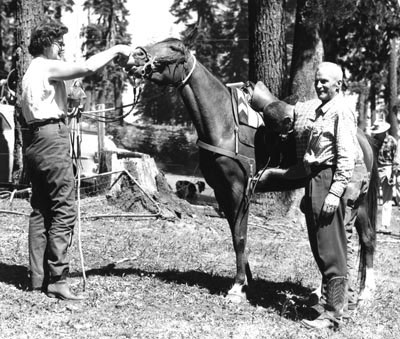
Wendell Robie's horse
being checked by Dr. Bob Bushnell
at Robinson Flat checkpoint.
1958. Photo by Charles Barieau.
Shannon Weil Collection.
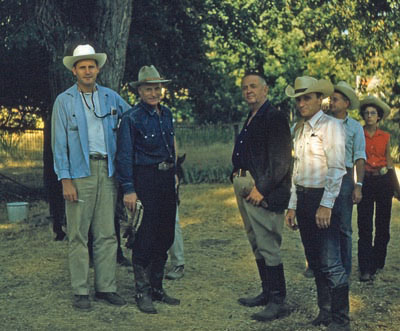
Pictured left to right: Dr. Don Jasper;
Wendell Robie; William Tevis;
Randy Steffen; Dr. Bob Goulding.
1959. Courtesy of Dr. Murray Fowler.
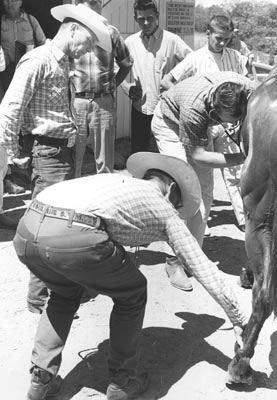
Pictured in foreground: Dr. Bob
Goulding. Dr. Bob Bushnell with
stethescope. At left: Paige Harper.
1962. Photo by Charles Barieau.
Courtesy of Kate Riordan.
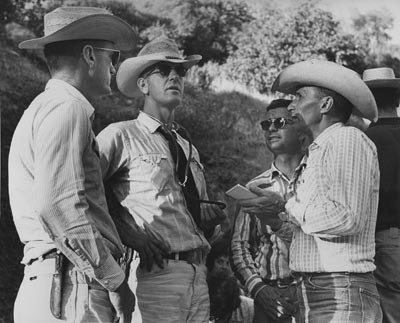
Pictured left to right: Al Fogo M.D.,
secretary to Dr. Barsaleau; Dr.
Richard Barsaleau; Dr. Bob Goulding;
Randy Steffen. Circa 1963.
Photo by Charles Barieau.
Courtesy of Hal Hall.
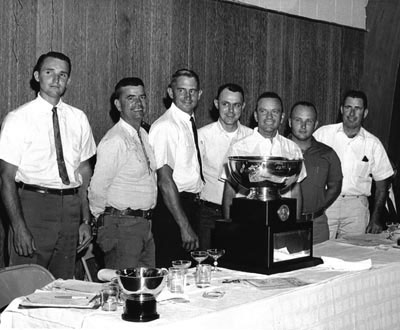
Pictured left to right: Dr. Bob
Bushnell; Dr. Bob Goulding; Dr.
Fowler; Dr. George Cardinet III; Paige
Harper, receiving the first Haggin Cup
Trophy; unknown individual; Dr. Dick
Chance. 1964. Photo by Charles Barieau.
Shannon Weil Collection.
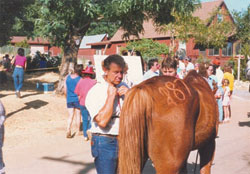
Dr. Jim Edwards examines Rufus,
ridden by Penny Scribner, at Michigan
Bluff. circa 1980. Photo courtesy
of Penny Scribner.
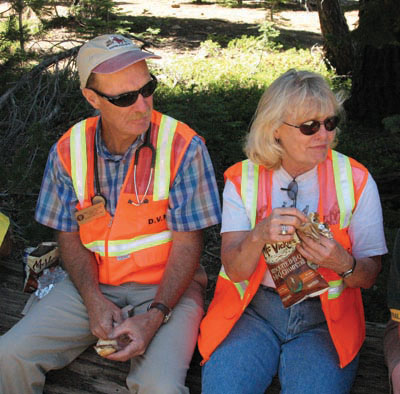
Current Head Vet Dr. Greg Fellers
takes a break with Head Vet Secretary
Judy Hall. 2007. Photo courtesy
of Penny Scribner.
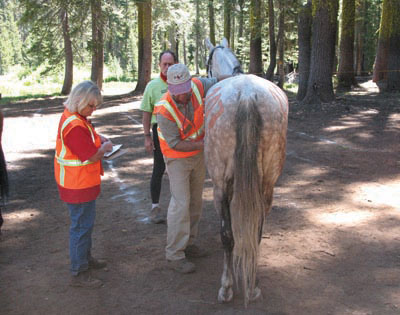
Dr. Greg Fellers, Head Vet,
examines horse while Judy Hall,
Head Vet secretary, makes notes
on rider card at Robinson Flat
checkpoint. 2007. Photo courtesy
of Penny Scribner.
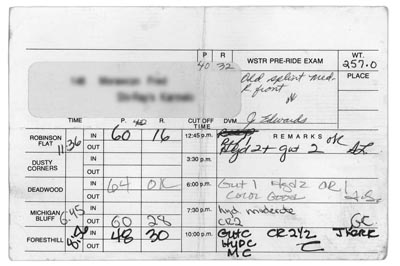
Example of old rider card.
Note the comment at the top about
"old splint." The card uses a
combination of AAEP (American
Association of Equine Practitioners)
number system for lameness evaluation
(1 = very slight, almost imperceptible;
5 = non-weight bearing). All the other
parameters are on a letter graded
system (Hyd = hydration; Gut = gut
sounds; CR = capillary refill).
Shannon Weil Collection.
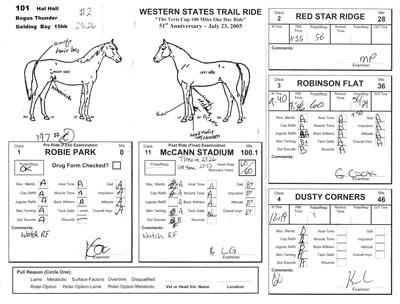
Example of new rider card.
Courtesy of Hal Hall.
A brief history of the use of veterinarians for the
Western States Trail Ride, 100 Miles 1 Day
The Western States Trail Ride, 100 Miles One Day, begins just south of Truckee and continues to the fairgrounds in Auburn. Today the ride is more commonly known as "The Tevis," after the Tevis Cup, which is awarded to the first horse and rider to finish. This annual, international, event was founded in 1955 by Wendell Robie, local businessman, avid horseman, and innovator. At that time the ride was an unknown quantity. "When we started there were no rules or criteria to go by," Wendell remembers. "They were developed as we went along."*1 From the beginning he insisted on using veterinarians. In 1956 three vets were used (compared to 17 staffed in 2007); Dr. Wheat and Dr. Kitchen of UC Davis, and Dr. Bullock of Auburn. The rules section of the 1957 welcome letter to ride starters, regarding vet exams, states "there is no chance of cruelty to tired horses with their inspection."
Dr. Robert Bushnell, a nephew of Robie, remembers the first year he vetted the Tevis in 1958 with 35 riders (compared to over 200 currently). "I remember it was just the two of us, me and Dr. Bill Lewis of Auburn," he says. "Lewis was a laid back kind of guy. We traveled to each checkpoint in an old jeep with a fishing pole sticking out the back. Lewis wanted to stop at every fishing hole. We really had to hustle."
In 1959 Dr. Murray Fowler became the chief veterinarian. He served as chairman of the veterinary examining committee for 15 years.*2 One year during Fowler's tenure, Drucilla Barner, Robie's secretary and the first woman to win the Tevis Cup, was diagnosed with terminal cancer. It was her last ride and her horse came up lame. Robie begged Fowler to let her finish. Robie told him, "I'll carry the horse if I have to." But Fowler couldn't do it. After all, he had helped develop the stringent vetting standards that Robie himself approved.
In 1961 Dr. Richard Barsaleau started vetting the ride and remembers a pivotal moment when he pulled Robie's horse for lameness. Robie was not pleased, but later walked up to Barsaleau, punched him in the arm, and said, "You were right." At the request of Mr. Robie, Dr. Barsaleau became chairman of the judging committee the next year and alternated in this head veterinarian’s role with Dr. Fowler for the next several years.*3
With experience, vets learned to be more objective in their analysis during post-ride examination. The awareness of the signs of an impending crisis improved due to the sheer number of horses examined on the ride. "We saw all gradations of fitness," the now 82-year-old Barsaleau says. The Haggin Cup Award was established for the best-conditioned horse of the first 10 finishing horses. Barsaleau was instrumental in making changes to the parameters of the award based on his philosophy that "the horse should be used, but not used up."
Dr. Todd Nelson, head vet in the 80's and early 90's, instituted changes to the number of one-hour-hold checkpoints (originally three and now two), the location of some checkpoints, and how horses are timed in. Moving the Devils Thumb checkpoint to Deadwood allows horses a mile to recover from the grueling series of switchbacks in the canyon they just climbed out of. A "gate-to-hold" was instituted where horses rest for one hour after their pulse has dropped to near normal. In earlier years riders could gallop their horses into a vet hold knowing they could use the horse's rest time to meet the pulse criteria, or "gate." These changes benefit the horse and encourage more responsible riding.
A shift in perspective occurred when vets judging the ride actually rode the Tevis. That experience became a valuable insight into the future of the event and the safety of both horse and human. Fowler was the first vet working the Tevis who entered the ride. Soon after, Barsaleau participated, completing 14 out of 16 starts. However, not all vets were eager to enter the ride. Dr. Jim Edwards, the longest acting vet on the vet committee, says that he and Nelson "were going to get a couple mules and ride it, but we made a pact that we’d call each other and talk until the feeling passed." According to Dr. Greg Fellers, head vet since 2005, "Sitting in the saddle for 24 hours is not my idea of a good time." Dr. Jamie Kerr, head vet from the late 90's until 2005, asked Fellers to take over as head vet, temporarily, so he could ride the Tevis. Kerr graciously bequeathed his title to Fellers as he continues to alternate between riding and vetting the Tevis each year.
Over the years the relationship between vet and rider changed, according to Penny Scribner, six-time Tevis finisher. "The first time I rode, vets strictly enforced rigid rules with little discussion with the rider or even with another vet," Scribner tells me. She attributes part of the change to Fellers. "The vets work with management and riders much more now instead of just showing up and acting as policemen," says Fellers. "There can be an adversarial relationship between vets and riders if you allow it, but it can be a win-win situation."
Fellers has seen riders often unwilling to see lameness in their horses even when it is obvious. The decision to pull a horse is a serious one and the rule has always been that a minimum of two vets consult on the matter. The main mode of communication between the vets is the rider's card. "As you can imagine on a 100 mile course," Fellers says, "we get strung along from hell and back." The cards pass along little "alerts." The rider's card has been reformatted for easier recording and communication.
One of the biggest changes, made recently, was to put in place exit exams at the two existing one-hour-hold checkpoints located at Robinson Flat and Foresthill. "We were letting horses back on the trail that might have needed another look," says Fellers.
Fellers has seen a "paradigm shift" while vetting the Tevis. "The level of care we can provide now is far better than, say, 10 years ago. I would dare to say that the Tevis is at the very forefront - in the field - in the level of care of horses that need treatment."
One of the main reasons for treating a horse is dehydration. "Some horses arrive ... dehydrated," Edwards points out. "They're already behind the eight-ball. They really need a day to get over the trailer ride." The challenge and working with his colleagues keeps Edwards coming back to the Tevis. "This is what it's all about. Looking at a fit horse ... and spotting something before a rider can even feel it," he says. "The Tevis is the ultimate. It's the oldest race and the toughest. It gets in your blood."
Footnotes:
1. The Tevis Cup by Verne R. Albright
2. Murray, Hummingbirds to Elephants and Other Tales, Autobiography of Murray E. Fowler, DVM
3. Endurance Ride Judging - How It All Began by Dr. Barsaleau, 2004 Tevis Forum
Author’s note: The history of vetting the Tevis has played a key role in the study of the horse under stress. The veterinarians mentioned here are only a small fraction of the many notable doctors who have included vetting the Tevis as part of their legacy in veterinary sciences. Much has changed since the Tevis started in 1955, but one thing has remained the same—the commitment of vets to keeping the horse healthy and safe.
For more information on the Tevis, visit www.foothill.net/tevis
Thursday, August 21, 2008
New and improved test for West Nile virus in horses
August 21, 2008
A new test for West Nile virus in horses that could be modified for use on humans and wildlife may help track the spread of the disease, according to an article in the September issue of the Journal of Medical Microbiology.
West Nile virus infects a wide range of animals, including humans, horses, dogs, cats, bats, squirrels, rabbits and birds.
It is widely distributed in Africa, the Middle East and Europe. It was first reported in North America in 1999, when there were human fatalities in New York City.
Since its arrival in the US it has spread rapidly across the continent. The virus sometimes causes swelling of the brain, or encephalitis, which can be fatal.
It is transmitted by several species of mosquito. Because the mosquitoes feed on so many different creatures the virus spreads quickly in areas where it has been introduced.
"Thousands of cases of West Nile virus have been reported worldwide, but 80% of infected people don't show any symptoms," said Dr Louis A Magnarelli, Director of The Connecticut Agricultural Experiment Station in the US.
"It is important to have highly sensitive and specific tests to diagnose infections and also to help track the ecology and epidemiology of West Nile encephalitis."
The US researchers have found that a new test designed to detect antibodies produced by horses is highly effective at diagnosing West Nile virus infections. Compared to the standard test for West Nile virus, the new test is much faster and gives accurate results. It was also useful in confirming past infections.
"Although the methods developed are for diagnosing West Nile virus in horses, the procedures can be easily modified to develop new antibody tests for humans and wildlife," said Dr Magnarelli.
"It is essential to test wildlife for infection to determine the ecological and epidemiological aspects of West Nile virus infections in nature so that we can try to control the disease by managing mosquito populations."
Diagnosing West Nile encephalitis in ill horses helps to identify areas where the virus is spreading and to make decisions about vaccinating horses. Laboratory diagnosis can also clarify the cause of undiagnosed neurological disorders.
"We tested 43 privately owned horses for the infection. The results showed that none of the horses with undiagnosed illnesses had been infected prior to the 1999 outbreak of West Nile virus in Connecticut, USA," said Dr Magnarelli.
"This kind of information is useful in confirming the epidemiology of the virus; determining when it arrived in certain areas and how it spreads."
Full Article
Tuesday, August 19, 2008
The Church of the Hoof
It’s been an interesting read, this shoe vs. barefoot theme. One truth about endurance is that since it’s a whole horse sport there is always something to learn about and obsess over. I think I’ve mastered the mechanics of the equine gut so I suppose now it’s time to start turning the pages of the equine foot.
I’ve been a shoe fan for years without really knowing why. I always just thought that horses needed shoes and to be frank, it’s easy to just nail shoes on and forget about it. I never had much of a problem with shoes and didn’t give it much thought. I didn’t think about the mechanics of lower leg movement, the force a horse exerts on the front end, the stresses and strains of tendons, or coffin bones or any of that soundness stuff. I never had a problem with it so I just didn’t worry about it. I was a default member of the “Shod Denomination.”
Then I watched this old silent 1925 documentary called “Grass” in which the nomadic Bakhtiari people in Southwest Iran migrate over the Zagros mountains twice a year to get to their grazing grounds…on unshod horses. Now that is some serious-ass-rocky-country. Their trip makes the Tevis look like a walk in the park (I think it’s still done, but most the people have moved on to the oil fields). I also have a couple photos from the 1920’s of Kurds riding their unshod horses on some pretty rough looking country. The Turkmen did some incredible things with their unshod Akhal-Tekes. The Cossacks did some major ass-whooping with their unshod horses, and it’s because their horses were unshod that they were able to defeat Napoleon’s shod cavalry during the winter months. Genghis Kahn almost conquered the world with unshod horses. Shoes obviously had their place in warfare, but they were no guarantee that battles would be won. The succcess
of a cavalry all boiled down to how the horses were kept and managed for the climate and type of warfare.
Back off that tangent on on to the subject: What furthered my “enlightenment” was that suddenly my mare developed this rather violent aversion to having nails driven in her rear left foot. She had to be sedated to be shod...and I mean almost falling over sedated. So shoeing became a stressful endeavor of coordinating a vet and a farrier to come to my place simultaneously. It was at this time I started seeing shoeless horses at rides and heard all sorts of miraculous stories about unshod horses from the “Barefoot Denomination.”
This whole debate of the shod vs. barefoot reminds me so much of differing interpretations of the Bible. Anyone that has spent any amount of time in an evangelical church can totally relate to this. It’s just about as emotional. The only difference is the opinion concerning who is going to Hell and whose horse is going lame.
But what it all this has done is resulted in people doing their own research and learning about the huge myriad of variables involved in hoof care. Yes, I am planning on the shoeless route with my mare because she has feet like steel and I live in a pretty arid climate. I’m a mile chaser so placement isn’t a big deal to me. If I need to go slow I go slow. I’ve still got a lot to learn about hoof balance and the mechanics of soundness. But I think we are on the right course. I don’t know if my colt will need shoes or not, but when we get there at least I will have done my homework and will be able to make a pretty sound decision (pardon the pun). I plan on being a member of the “Hoof Health Denomination.” It should be a pretty lively place to be with lots of arguing, and back and forth with everything being subject to question. But we’ll learn a lot I think.
Lynn
Navigating Changing Times
Back Country Horsemen of Washington Illustrate Success
Graham WA: This quote from Back Country Horsemen of Washington (BCHW) President Bob Gish hints at the winding road this 3,500 member organization has had to traverse in order to fulfill its mission of securing the recreational use of horses and mules on public lands. Mr. Gish outlined some of this journey, as well as several major accomplishments his organization has secured, at BCHW's Annual Meeting.
As any BCHA chapter member knows, volunteering to help with the maintenance, repair, and establishment of trails and equestrian faculties on public lands is critical to the continuation of stock use in the back country. Not only does volunteer work fill a void left by many a stretched state or federal budget, "research indicates that volunteering adds to the overall economic output of a community, helps build cohesive communities, and fosters trust between citizens," adds Mr. Gish. Hearing the call, BCHW members have consistently increased their organization's annual number of volunteer hours from almost 28,000 in 2002 to just over 63,000 in 2007, the equivalent of a $1.462 million donation to Washington's public lands. Although a sizable amount, BCHW leaders warn that the tallied hours are a drop in the bucket compared to the amount of work still needed to be done in Washington's National Forests, and members stand ready to clock even more hours in 2008 and beyond.
BCHW has also been hard at work building partnerships and promoting the horseback riding community as responsible stewards of the land with other pro-recreational use groups as well as local, state, and federal land managers and elected officials. With increasing demands on Washington's public lands from other user groups, BCHW leaders view these collaborations as vital to continued equestrian access. "Remember the saying - the whole is greater than the sum of its parts. Only with reciprocal relationships and coordination will we be able to target and manage our resources effectively," said Gish. To this end, the organization's Public Lands Committee has worked with motorized and non-motorized user groups to plan relevant breakout sessions for the Washington State Trails Coalition annual meeting, successfully negotiated wording with the Washington Department of Fish & Wildlife that raised the number of persons gathered in a group requiring a commerce permit from 5 to 30, and has encouraged local chapters to assist the Forest Service in controlling the spread of invasive weed species on public lands.
BCHW has also been highly successful on another front in its mission to keep public lands open to equestrian use - legislation. "Our organization has had to broaden its scope out of necessity to include less familiar territory because our mission is under siege," Mr. Gish warned members several years ago. "BCHW must shift to encompass expertise in policy and lawmaking to counter rules and policies that would restrict access to public land by stock users just as effectively as if a trail was closed by a downed tree and no one was chainsaw certified." His message was taken to heart, and in 2007 BCHW accomplished a remarkable achievement by claiming a hard-fought victory in passing Washington's Right-to-Ride legislation. It was the first time that any BCHA organization successfully introduced and had legislation passed to protect equestrians' right to ride.
Today, BCHW continues along the many avenues it has forged in its quest to protect access for horse and mules riders on Washington's public lands. Volunteers continue their hard work in the back country, new affiliations with non-equestrian groups are being sought out, and advocacy in the marble halls of state and federal legislatures carries on. "We (BCHW) can be very proud of what we have accomplished, and I hope that we remain filled with enthusiasm for what is in store for our future as BCHW undertakes to navigate the changing times in which we live, work, and play," said Mr. Gish as he summed up his organization's many achievements while looking ahead to future success.
Back Country Horsemen of Washington is a state organization of Back Country Horsemen of America, a 13,000 member national organization that promotes recreational stock use on public lands. To learn more, please go to www.backcountryhorse.com or telephone 888-893-5161.
Monday, August 18, 2008
Sweet feed can make young horses naughty, says study
August 19, 2008
Young horses may be easier to train if they temporarily lay off the sweet feed, according to Montana State University (MSU) researchers.
A commercial mixture of corn, oats, barley and molasses - sometimes called "sweet grain" or "sweet feed" - gives horses the glossy coat and lively spirit that makes them attractive to prospective buyers, said Jan Bowman, an animal nutritionist at MSU.
But the extra energy provided by sweet grain during the early stages of training made horses in an MSU study more disobedient and fearful than horses who ate only hay, Bowman said.
The grain-eaters spent more time resisting the saddle...
More...
Friday, August 15, 2008
Snake Bite Preparedness
by: Edward D. Voss, DVM, Dipl. ACVIM
October 01 2005, Article # 6165
Q: Our area has a healthy population of rattlesnakes. We spend six to 10 hours a week on trails where we have seen snakes. I would like to be prepared in the event one of our horses gets bitten. What are the procedures and supplies we should have on hand? Pat
A: When on excursions into areas frequented by pit vipers (also called crotalids, including rattlesnakes), it is prudent to consider some basic precepts concerning bites. Approximately 20-60% of bites are "dry" or defensive type of bites with little or no venom injected by the snake. These are bites that do not swell much within 10 to 15 minutes of being bitten and are not overly painful. It is difficult to ascertain whether a bite is dry, so assume envenomation (injection of venom) and proceed to obtain veterinary care. Rapid swelling and pain suggest venom injection. Venom has a Super Glue-like consistency and is absorbed rapidly from the bite site within 30 seconds to several minutes. Cutting an incision on the bite and suction is not recommended; icing of the bite is not a good idea, nor is a tourniquet.
Most bites occur on the muzzle in curious horses, and application of a dry absorbent wrap is not possible. Things to consider bringing on such excursions would be:
More...
Saturday, August 09, 2008
APEX clinic at Vermont 100
APEX – One Participant’s Perspective
Plan B
Sometimes when life hands you lemons, you make lemonade.
Or better yet, if life hands you potatoes, you use the spuds to make yourself some outstanding vodka. And whip up a Cosmopolitan.
With the Vermont 100 one of the few rides on my schedule this year given the all-consuming construction of our house, I was primed to take Ned there for a third-times-a-charm stroll around the course.
But the fates had other ideas in mind: A way-too-hot forecast for heat-challenged half-Trakehner Ned, then a leaking transmission line on the hauling vehicle, topped by a key crew member who ended up on the losing end of a pedestrian/cyclist meeting with two broken wrists – all pointed to opting out of the ride.
Enter Plan B … I was reminded of the APEX Clinic happening the Tuesday through Thursday before the ride, and just around the corner from camp by Cecily Westervelt, a fellow member of the active New 100 Miler yahoo email list.
In a moment of rare spontaneity, I headed to a client meeting on Tuesday, then just kept driving northeast to Vermont.
What To Expect
A quick glance at the APEX website (www.apex-us.org) revealed clinicians I knew by name and reputation, if not personally: Stagg Newman, Kerry Ridgway, Ann Stuart, John Crandell III, Doug Lietzke, Jeff Pauley.
Would this clinic be over my head? (I consider myself to be a 100-miler newbie, with only 5 completions under my belt and less than a decade of endurance competition to my credit.)
Would it be geared toward international competition? (FEI level riding isn’t my cup of tea.)
Would it be too basic? (After all, I am not exactly new to the sport.)
Would I find out that the little success I’d already had was pure fluke and that I was a living breathing role model of What Not To Do? (Uh oh.)
Be Welcome, Come Learn, Share Ideas and Resources
From a speedy response to my last-minute “Can I come?” to the warm welcome offered by Gene Limlaw, the local rider who organized the clinic (hosted by the Rojek’s Smoke Rise Farm), to the hot coffee waiting in the Carriage House (which served as our lecture hall), to the little welcome bag of goodies we received from Slypner’s Gear, I immediately felt right at home.
Gene and Cecily filled me in on the previous evening’s goings-on since I had been absent. Conformation and shoeing analysis of less than perfect, real life with each clinician offering their perspective, a goal-setting discussion, and an overall theme of how to make your horse the best, most enduring it could be.
As the morning progressed and Ann Stuart, DVM, presented a lecture and video synopses about Recognizing Lameness, it became obvious to me that this clinic was all about learning, and sharing ideas, and enhancing a sense of community.
Participants and “experts” alike laughed over their wrong guesses about which leg was lame, which was primary versus secondary, what might be compensatory. Many of us were just relieved that we could see the horse was lame, and that yes, it was Grade 3 by AAEP criteria which would mean you were done for that day in an AERC ride.
Over and over, the “experts” talked about how they deferred to others, how they realized they didn’t know everything, how they’d learned through (often embarrassing) mistakes, how a specific program (even their own) -- be it electrolyting, conditioning, post-ride leg care, shoeing – wasn’t the be-all or end-all, it was just what worked for them.
On to Jeff Pauley, a SE Region Master Farrier whose wife, Leigh Ann, competes successfully in 100-mile rides. Jeff presented a multitude of shoeing set-up suggestions for various types of rides – concussive, sandy, rocky, slippery terrain. Again, he emphasized taking advantage of the network of farriers shoeing endurance horses around the country – make phone calls, drop emails, ask some questions about what shoeing set up might make sense for a particular ride – cultivate and use your resources was his primary message.
In a light-hearted moment, Jeff spoke about the best time to approach your farrier about new ideas – somehow, it seems that some horse owners like to have these chats while the farrier is bent over in concentration, sweating over a hoof, 99% done with the trim.
A better idea might be to call ahead and ask your farrier to schedule a little extra time for the beginning of the shoeing appointment to watch the horse go, chat about the shoeing set up for your next ride, and bounce some ideas off each other. Jeff also discussed the upcoming Shoeing for Endurance clinics being hosted by Kentucky School of Horseshoeing (see the APEX website for more details).
Ann and Jeff agreed that farriers and vets are getting better and better about working together on sport horse foot and leg care. They pointed to the upcoming AAEP (American Association of Equine Practitioners) Convention (http://www.aaep.org/convention.htm) in December, 2008, where a full day will be dedicated to the farrier/veterinarian partnership.
The treadmill demonstration was impressive, and I am so looking forward to making my Christmas Wish List for Santa, as one of these is right near the top. What a tool!
Phoenix, a Decade Team horse ridden by Dinah Rojek, cheerfully went through his paces on the treadmill, and participants were able to pick up dozens of things – the foot flight of the horse, the way the horse landed (heel first? lateral? medial?), how the heart rate responded to changes in gait at the same speed (Phoenix is an efficient canterer), and just how critically important actually moving through space is to the thermoregulation of the horse (without the fan running, Phoenix overheated rather quickly).
The good news is that those of us not on Santa’s Good Child List can reap many of the advantages of the treadmill in a low-tech way. There are ways of getting videotape of a the foot flight of a horse in motion, some better suited for the risk-tolerant than others, all requiring a bit of patience and planning and a steady hand.
John Crandell spent some time, both at the treadmill and in the classroom, talking about how successful endurance horses tend to be narrow, thus able to more efficiently move their body mass through air. As John emphasized, these were the horses that could move with economy; these were the survivors in nature. For endurance, however, these horses present a shoeing challenge because of their relatively narrow path of hoof travel, and the close tolerances for perfect balance over long and challenging distances.
Jeff and John, both farriers, agreed that farriers do not create balance issues, they sometimes just don’t catch them soon enough, particularly if riders fail to communicate about small changes the may or may not notice.
Kerry Ridgway, DVM, moved us back to the internal function of the endurance horse, with an enlightening and sobering look at the impact of ulcers, and the management and feeding and medical remedies available, both at home and in competition, as allowed by the new AERC drug rules.
Kerry discussed his upcoming study with Frank Andrews, DVM, regarding acupuncture as both a diagnostic and treatment tool. This is a topic endurance riders should look forward to hearing more about! While it is clear that while ulcers are not a new problem, the research about them is evolving, as is the approach to addressing them.
During the breaks, participants chatted with the clinicians, picking their brains, seeking ideas, coming up with possible solutions to specific problems. This was the rubber meeting the road.
Jim Masterson (www.mastersonmethod.com) demonstrated an integrated method of massage for horses, using Finch, one of Smoke Rise Farm’s horses, as a subject. The great thing about this method is that it is intended to be one that horse handlers can perform themselves. Finch is a stoic sort, but we all watched in fascination as Jim’s work, even with the lightest of pressure, elicited responses from Finch – twitching of his lips, blinking, changes in breath, snorting, shifting of weight or fidgeting, to repeated and enthusiastic yawning – that showed release of tension.
An additional handful of horses were brought in for hands-on practice, each with different tight spots and personalities, and one of the many messages brought home, as in so many situations with horses, is that less is more. When a horse would resist, many of us would push or pull through, rather than lightening our touch and guiding the horse along. The light touch worked much better!
At the end of a long day Kerry Ridgway gave a saddle fitting demonstration, using a systematic approach (http://www.ultimatesaddlesolutions.com) to check the saddle, the horse, and the fit of the saddle to the horse, to include the placement and rigging of the girth or cinch. Kerry gave us his opinions and anecdotal stories about specific brands and types of saddles but the overall theme of that discussion was, as it is so many times with endurance riding I’ve learned, “Whatever Works!”
Day Three – As Joan Rivers would say, “Can We Talk?”
The third day of the clinic came too soon, culminating the previous days’ learning, with round-robin small team work with each of the following – John Crandell, Stagg Newman and Doug Lietzke. Doug gave us a lecture about positive imagery and using sports psychology tools to excel in our sport. Fascinating, and applicable in a very practical sense.
We shared stories, ideas and techniques. We laughed, we confessed our inadequacies and challenges and strengths, as well as those of our horses. I won’t share the inadequacies, other than to say that even the legends are human (or equine) in their imperfection. Being less than a model of perfection, myself, and having a herd of beasts for whom I can point out every flaw and shortcoming, this is considerable comfort.
Something I scribbled in large letters in my notes -- “There are NO formulas!” Conditioning, electrolyting, post-leg care, whether a young horse was ready for his first CTR, 50, 100 or ready to race – each participant there, including and with emphasis on the “experts,” had their own opinions, experiences, ideas, and strategies.
And in the end, one of the predominant messages was summed up in a presentation by John about a “Virtual Stable”, in which the endurance community in the U.S. can work together, pool resources, and share in one another’s successes and learning experiences.
Since so many of us have only one or two horses, why not set up a network with so many others like ourselves, so that we can learn and share and commiserate and set community goals so that we can belong, virtually, to a much bigger stable? It will make the highs higher, the lows a little less traumatic, and celebrate our collective successes.
The creation of a “virtual stable”, in a nutshell, is the message behind APEX.
Patti
Friday, August 08, 2008
Shoulda been a cowgirl
By Wendy Lautner
Tahoe.com assistant editor Wendy Lautner had the chance to catch up with the busy Phyllis Keller, vice president of the Truckee-Donner horsemen/women this week. In between putting on the Truckee Championship Rodeo this week and preparing for a 100-mile horseback ride in Santa Cruz on Aug. 16 she offers up a little advice for folks wanting to get on the trails in the Tahoe area. Check out what she had to say below.
Tahoe.com: Tell me a little bit about your experience riding horses?
Phyllis: I started riding when I was in fifth grade, in Montana. My father was in the Air Force and we were stationed in Great Falls. I needless to say was horse bit and developed friendships with other kids who had horses. It was ride by the seat of your pants in those days.
My father retired which brought us to California. I had always wanted to ride over fences and after graduation from high school that’s what I got involved in. I purchased my first horse and got started. I rode for a few years, the bigger fences the better. I have wonderful memories of those years.
More...
Wednesday, August 06, 2008
How to know if your horse has problem hooves?
 By Chrisann Ware
By Chrisann WareEquine Myofunctional Therapist, UHHGM
& Co-ordinator Equethy Barefoot Workshops (Aust.)
As an Equine Myofunctional Therapist dealing daily with equine musculo-skeletal problems and through Equethy workshops (who have now delivered hundreds of workshops all over Australia in the past seven years), I have had the pleasure to meet many horse owners who turned to barefoot rehabilitation.
he comment I hear all the time after they see the dramatic changes that occur both in hooves and bodies is “I wish I had known how to spot hoof problems earlier.... I could have helped my horse years ago instead of wasting all that time while he was getting steadily worse......I feel like such an idiot!"
I tell them "don't" because you are not alone. I was just the same at one time until I learned a little hoof anatomy.
Many horse owners know instinctively that their horses are “not quite right. They ask their farrier who says “well he doesn’t have great feet but just keep him shod and he will be OK.”
...More at Equethy.Com"
Monday, August 04, 2008
NoHands Bridge
 Ben Furtado/Auburn Journal
Ben Furtado/Auburn JournalGordon Ainsleigh stands below Mountain Quarries Railroad Bridge ? also known as No Hands Bridge. The first man to complete the Western States Endurance Run, Ainsleigh sees No Hands Bridge as a ?bridge to the promised land.?
The Mountain Quarries Railroad Bridge once connected Auburn with the vast resources of the American River Canyon. In modern times the structure spanning the American River serves as a beacon for weary equestrians and endurance runners.
The landmark commonly referred to as “No Hands Bridge” connects the rugged Western States Trail with the final climb to Auburn, leading runners from the wilderness to civilization.
“No Hands is our bridge to the past and to our future,” said Gordon Ainsleigh, who was the first man to run the Western States Trail from Truckee, which led to the founding of the Western States Endurance Run two years later. “For those of us in the Auburn area who have sweated so much, breathed so much and lived so much of the best of our lives on that trail through the wilderness to Tahoe that we usually access only by No Hands, it’s like a bridge to the promised land.”
The bridge was erected in 1912 by the Pacific Portland Cement Company to connect its limestone quarry to the Southern Pacific main line in Auburn. At the time of its construction, the bridge was the largest concrete arch bridge in the world. More than 800 men worked on the construction of the bridge, which cost $300,000 to build.
When the railroad ties were removed in the 1940s, the bridge was relegated to primarily serving adventurous equestrians like Wendell Robie. The Auburn businessman founded the Western States Endurance Ride in 1955. He was also the driving force behind the creation of the Western States Endurance Run more than 20 years later.
The Mountain Quarries Railroad Bridge’s unique design has survived numerous floods while other bridges in the area failed. In 1964, the Hell Hole Dam gave way and the ensuing flood took out two bridges up-river. The cement structure was pressed into service, providing the link between Placer and El Dorado counties while the Highway 49 Bridge was being rebuilt.
The “Valentine’s Day” flood of 1986 knocked out two bridges to the west while the Mountain Quarries Bridge held firm.
The nickname “No Hands Bridge” came about prior to the installation of handrails along the bridge in 1984. While most equestrians would dismount to cross the guardrail-less bridge, veteran rider Ina Robinson would drop her reins and cross with no hands, leading to the catchy nickname.
The bridge’s rich history is now a major part of the endurance community. The bridge is the last major monument before runners reach the Placer High track and the finish of the Western States Endurance Run. The bridge has witnessed some major drama in the Tevis Cup. In 2007, Jeremy Reynolds passed John Crandell between No Hands and the finish line in Auburn to win.
The bridge stands less than four miles from the Western States finish line, though the final climb out of the canyon has claimed many a runner.
No Hands Bridge was closed temporarily in 1995 and ’96 when it was discovered the footings on the mid-river abutment were failing. However the bridge was opened temporarily for both Western States and Tevis Cup.
Congressman John Doolittle, R-Roseville, was able to appropriate $700,000 for the repairs on the bridge, which were completed in ’96.
Auburn’s Hal Hall helped lead a major effort to have the Mountain Quarries Bridge listed on the National Register of Historic Places in 2004 by the U.S. Department of the Interior. The bridge has been a huge part of Hall’s life as one of endurance riding’s most decorated competitors.
Ainsleigh couldn’t picture life without No Hands Bridge, the gateway to a land that remains the wild west.
“The trail basically follows the drainage of the middle fork and it’s our connection to that,” Ainsleigh said. “It’s like so much of our lives are connected to this trail and this bridge is kind of sacred ground.”
The Journal’s Todd Mordhorst can be reached at toddm@goldcountrymedia.com or comment at AuburnJournal.com
--------
Fast Facts:
Mountain Quarries Railroad Bridge
Commonly referred to as No Hands Bridge after being dubbed such by endurance rider Ina Robinson in the early 1980s, who would drop her reins and ride across the then guardrail-less bridge with no hands.
Built by John B. Leonard and completed on March 23, 1912.
The bridge is 15 feet wide, 482 feet long and 70 feet high at average water flow.
The U.S. Department of the Interior placed the bridge on the National Register of Historical Places in 2004.
Gordon Ainsleigh
The chiropractor from Meadow Vista was the first man to run the Western States Trail from Truckee to Auburn – 100 miles – in 1974.
The Western States Endurance Run was founded two years later and Ainsleigh has finished the run 22 times in 30 hours or less.
Ainsleigh now serves on the Auburn Recreation District’s board of directors.
